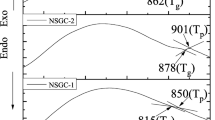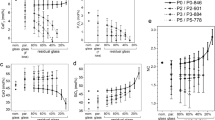Abstract
Four fluorcanasite glass-ceramics were fabricated by controlled heat-treatment of as-cast Glasses A–D. These compositions have been reported previously but essentially, Glass A had the stoichiometric composition (Ca5Na4K2Si12O30F4) and Glasses B–D were modified by reducing the Na2O concentration (B), adding excess CaO (C) and P2O5 (D). The latter two compositions have been shown to have promising bioactive response in cell culture and simulated body fluid experiments. Devitrification of the stoichiometric composition resulted in poor mechanical properties with crumbling often observed on machining. As a result, no mechanical data could be obtained. In all modified compositions, heat-treatment between 780 °C and 900 °C resulted in measurable indentation fracture toughness (IFT) and biaxial flexural strength (BFS). IFT was optimised in Glass C at 800 °C (2.53 ± 0.02 MPa m½), but the biaxial flexural strength (BFS) was low, 167 ± 17 MPa, compared to other compositions. For heat- treated Glass D optimum mechanical properties were obtained at 800 °C with BFS and IFT, 249 ± 23 MPa and 1.95 ± 0.01 MPa m½, respectively. The relationship between the mechanical properties and microstructure is discussed.






Similar content being viewed by others
References
Jarcho M, Bolen CH, Thomas MB, Bobick J, Kay JF, Doremus RH (1976) Hydroxylapatite synthesis and characterization in dense polycrystalline Form. J Mater Sci 11:2027
Hench LL (1998) Bioceramics. J Am Ceram Soc 81:1705
Hench LL, Etheridge EC (1982) Biomaterials: an interfacial approach. Academic Press, New York, pp 1–7
Kokubo T (1993) A–W glass-ceramic: processing and properties. In: Hench LL, Wilson J (eds) An introduction to bioceramics. World Scientific, London, pp 75–88
Beall GH (1991) Chain silicate glass-ceramics. J Non-Cryst Solids 129:163
Mirsaneh M, Reaney IM, Hatton PV, James PF (2004) Characterisation of high fgracture toughness k-fluorrichterite fluorapatite glass-ceramics. J Am Ceram Soc 87(2):240
da Rocha Barros VM, Salata LA, Sverzut CE, Xavier SP, van Noort R, Johnson A, Hatton PV (2002) In vivo bone tissue response to a canasite glass-ceramic. Biomaterials 23:2895
Miller CA, Kokubo T, Reaney IM, Hatton PV, James PF (2000) Nucleation and crystallization of canasite-fluorapatite glass ceramics. Int Symp On Crystallization in Glasses & Liquids, Glastech Ber Glass Sci Technol 73(C1):154
Miller CA, Reaney IM, James PF, Hatton PV, Kokubo T (2001) Glass ceramics for bone tissue repair. Proc Int Congr Glass 2:601
Miller CA, Kokubo T, Reaney IM, Hatton PV, James PF (2002) Formation of apatite layers on modified canasite glass-ceramics in simulated body fluid. J Biomed Mater Res 59:473
Miller CA, Reaney IM, Hatton PV, James PF (2004) Crystallization of canasite/frankamenite-based glass-ceramics. Chem Mater 16:5736
Bandyopadhyay-Ghosh S, Reaney IM, Hurrell-Gillingham K, Brook IM, Hatton PV (2005) Evaluation of modified flurocanasite glass-ceramics for bone tissue augmentation. Key Eng Mater 284–286:557
Bandyopadhyay-Ghosh S, Reaney IM, Brook IM, Hurrell-Gillingham K, Johnson A, Hatton PV (2007) In vitro biocompatibility of fluorcanasite glass-ceramics for bone tissue repair. J Biomed Mater Res: Part A 80A(1):175
Kanchanarat N, Miller CA, Hatton PV, James PF, Reaney IM (2005) Early stages of crystallization in canasite-based glass ceramics. J Am Ceram Soc 88:3198
Ponton CB, Rawlings RD (1989) Vickers indentation fracture toughness test: part 2 application and critical evaluation of standardized indentation toughness equations. Mater Sci Tech 5:961
Matsumoto RLK (1987) Evaluation of fracture toughness determination methods as applied to ceria-stabilized tetragonal zirconia polycrystal. J Am Ceram Soc 70(12):C366
Morrell R (1998) Biaxial flexural strength testing of ceramic materials. National Physical Laboratory, Teddington, Middlesex, UK
Shetty DK, Rosenfield AR, McGuire PA, Bansal GK, Duckworth WH (1980) Biaxial flexure tests for ceramics. Ceram Bull 59:1193
Wolcott CC (1994) Canasite apatite glass-ceramics. US Patent 5, 336, 642
Beall GH, Chyung K, Stewart RL (1986) Effect of test method and crack size on the fracture toughness of a chain-silicate glass ceramics. J Mater Sci 21:2365
Author information
Authors and Affiliations
Corresponding author
Rights and permissions
About this article
Cite this article
Kanchanarat, N., Bandyopadhyay-Ghosh, S., Reaney, I.M. et al. Microstructure and mechanical properties of fluorcanasite glass-ceramics for biomedical applications. J Mater Sci 43, 759–765 (2008). https://doi.org/10.1007/s10853-007-2180-y
Received:
Accepted:
Published:
Issue Date:
DOI: https://doi.org/10.1007/s10853-007-2180-y




